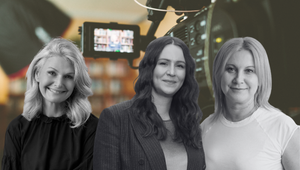
"We Contribute More" and Make "Better Work": Why Agencies Should Involve Directors Earlier

A director is likely almost the last person to join a TV commercial project, sometimes after casting is complete and music commissioned. But production industry leaders are challenging this paradigm, arguing that involving directors early could lead to better, more interesting creative.
Mint Films executive producer and director Andrew Seaton is one filmmaker craving more collaboration with agencies. Shrinking budgets continue to squeeze productions, and rather than leaning into more dynamic workflows, big agencies seem reluctant to alter the status quo. Andrew sees bringing directors into the process earlier as a smart creative move.
“I think it will ultimately lead to better work,” Andrew told LBB. “Collaboration is essential, and working with a director who feels heard and valuable… [they want] to make the work as great as it can be.
“As budgets become more challenging, bringing this collaboration in earlier means concepts, scripts, and ideas aren’t totally set in stone and clients aren’t attached to executions that might not be achievable on their budget.”
Andrew isn’t alone. New Zealand director and Film Construction founding partner Perry Bradley has also helped agencies “shoehorn big ideas into small budgets.”
“Many times in my career I've been brought in early and it's always useful,” Perry said.
“Directors aren't producers -- we're better at spending than saving, so we can't be trusted with budgets.
“But we're good at asking questions, suggesting locations, and we can quickly suggest techniques to make things work. That's where we add value early, rather than coming in after months of creative development, when there might be some resentment about changing direction.”
“[For agencies], relinquishing control is tricky, but the earlier [directors are] involved, the more we all feel ownership, which benefits the project.
“It’s not a resistance -- creatives have a hard job wrangling clients. If early involvement became standard practice, it would help everyone.”
Traditionally, a director is brought onto a project once the client has signed off on approved scripts. This can make the director’s job more challenging, as ideas, creative, scripts, and even animatics are set in stone and have gone through legal departments.
ANTI co-founder and EP Amanda Chambers told LBB that by the time client amendments are done, there have already been several rounds of feedback and iteration.
“At most big agencies, the traditional process of bringing a director on board doesn’t begin until there have already been rounds upon rounds of creative decks developed by the creative teams, followed by rounds of feedback from an ECD, not to mention strategy and account management feedback,” Amanda said.
Finally, when three concepts and a preferred script are presented to the client, the production company enters the conversation.
“More often than not, the final scripts would be given to production to align in what may sometimes be only an hour before a client meeting,” Amanda continued.
“In an ideal world, production would be given 48 hours for due diligence -- but this became more and more rare over my years in agencies.
“By the time an approved script is handed to production to start talking directors, the budget has been massively diluted, and there is never enough client money left for production to bring to life the desired outcome.”
Among the biggest barriers to bringing directors in earlier, Amanda believes, are pitching constraints.
“The larger networks and clients generally still require three treatments from three different directors. This means that a creative bringing in a director early at an agency level is an awkward situation, as the client will more often than not have the final say in deciding on the awarded director.
“Some creative directors see themselves as directors, and like to fully flesh out the idea themselves, almost frame by frame -- or even worse, using AI to do it. This often backs a director into a corner, when every detail has already been sold in up the chain, and prevents a director being able to bring their magic to the table.
“Agency creatives tend to be time poor in reduced-sized teams these days, so to spend time collaborating with a director when their timesheets need to equate to dollar value against a client is difficult for them.”
Production companies are also usually required to pitch for work, and in an industry fighting for every dollar, Amanda said production partners are wary of helping agencies develop ideas for free.
“They may have tried this in the past, only to find the agency awards the job to the [cheapest option] in response to client demands.
“Good-hearted ECDs are often reluctant to impose on production companies to ask for these early idea sharing sessions, as there is no money in it for the production house until a job is awarded. Badly-behaved ECDs will get whatever they can from a director, but then may still not award the job their way.
“Equally, a director’s early involvement, like treatments, can be expensive and time heavy, which becomes risky in a culture with less loyalty to existing production partners.”
Sydney photographer and filmmaker Cybele Malinowski decried the squeeze this process puts on production.
“The pressure to deliver small miracles on ever-shrinking budgets only exacerbates the issue,” Cybele told LBB.
“The meticulousness required in the treatment and quoting stages to achieve high-quality results within those constraints adds another layer of time and effort to this front-end process. The extended selection timelines then ironically compress the already limited window for the awarded team to actually execute the production. It's a system that feels increasingly unsustainable and counterproductive.
“Time could be far better spent actually making great work, nurturing creative growth through personal projects, and proactively generating new business opportunities.”
In contrast, when awarded a job with little to no pitching, there is a perception of trust in a director’s vision and capabilities that fosters true collaboration and better work.
“When I worked production side at Assembly, most ideas were fleshed out at an early stage in partnership with the Assembly creative partners, around the bar or in the library late at night,” Amanda said.
“These ideas often grew into internationally awarded work, due to that collaborative process and those incremental extensions of the original ideas.”
It begs the question: How much excellent work is being left on the table due to the energy consumed by a demanding and speculative pitching process?
Following the viral response to her series of aerial photographs of the 2019 bushfires, Cybele invited brands and agencies to collaborate on a piece addressing the devastation.
The ultimate collaboration between Greenpeace and prodco Collider, ‘Climate Changed’, was born from a unique offer from the brand to support Cybele’s creative vision from the outset.
“I was able to work with an incredible team, including one of my all-time favourite composers James Brown,” Cybele said.
“This raw and subliminal reflection on the bushfires' aftermath, achieved with a modest budget, benefited massively from the absence of a demanding pitch and restrictive client demands. The creative process remained fluid, allowing for adaptation and the natural evolution of ideas.”
The recent ResMed work, made with Hopeful Monsters and Mint Films, is another recent example, wherein Andrew joined the process prior to any script being written.
“It was a great process … we got the opportunity to do a writers' room with the agency and client and come up with ideas that would eventually make up our script,” Andrew said.
“It was a really unique way of working -- it meant that we got to tell the story in a really interesting way, but also that agency, client, and production were all intensely invested in it.”
Perry also mentioned a project for NRMA, in which his early involvement let him understand his client’s priorities, anxieties, and goals.
“It was invaluable for me as a storyteller,” Perry said. “The creatives were generous with collaboration. In my experience, the earlier filmmakers are involved, the better the results -- we contribute more when we're invested from the start.”
A recent Australian campaign for SEEK saw Canadian director Taso Alexander brought in earlier than usual. Speaking to LBB, Taso described the process as being extremely valuable in his creative process.
“The edits were approved so quickly … they were really trusting of me all the way through. It was absolutely useful."
“They were really trusting of me all the way through. It was absolutely useful. It was all approved incredibly quickly, faster than normal for sure, because they budgeted so much time on the back end for the client to go through variations.”















